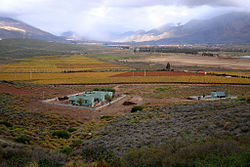This article needs additional citations for verification .(July 2011) |
De Doorns | |
|---|---|
 A view of the Hex River Valley | |
| Coordinates: 33°29′S19°41′E / 33.483°S 19.683°E | |
| Country | South Africa |
| Province | Western Cape |
| District | Cape Winelands |
| Municipality | Breede Valley |
| Government | |
| • Councillor | Daniel Teswin Willemse |
| Area | |
• Total | 7.6 km2 (2.9 sq mi) |
| Population (2011) [1] | |
• Total | 11,278 |
| • Density | 1,500/km2 (3,800/sq mi) |
| Racial makeup (2011) | |
| • Black African | 40.0% |
| • Coloured | 51.5% |
| • Indian/Asian | 0.6% |
| • White | 6.0% |
| • Other | 1.9% |
| First languages (2011) | |
| • Afrikaans | 64.0% |
| • Xhosa | 25.2% |
| • Sotho | 3.7% |
| • English | 2.5% |
| • Other | 4.5% |
| Time zone | UTC+2 (SAST) |
| Postal code (street) | 6875 |
| PO box | 6875 |
| Area code | 023 |
De Doorns is situated in the Breede Valley Local Municipality, Cape Winelands District Municipality in the Western Cape province of South Africa.


